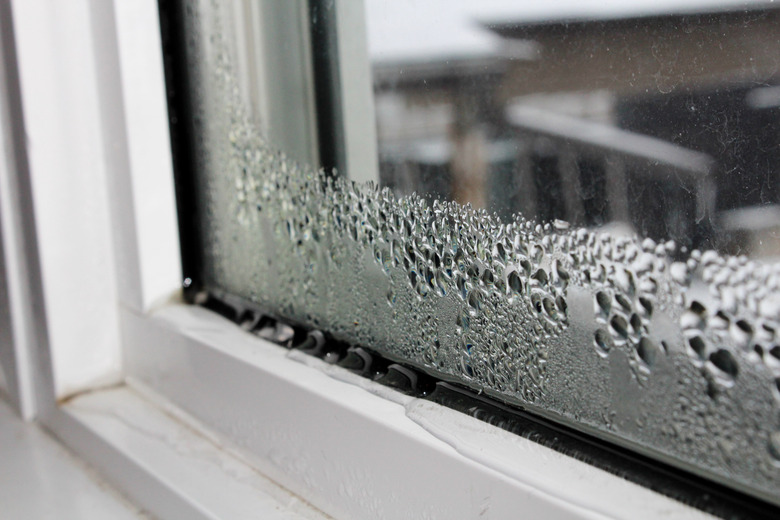How Temperature & Humidity Are Related
The Earth's atmosphere plays host to numerous weather phenomena that affect life and shape the planet. Understanding these phenomena requires knowledge of the interaction between temperature and humidity. Temperature affects humidity, which in turn affects the potential for precipitation. The interaction of temperature and humidity also directly affects the health and well-being of humans. Relative humidity and dew point, values commonly used by meteorologists, give the means to understand this interaction.
TL;DR (Too Long; Didn't Read)
Temperature and humidity affect the Earth's weather, human health and human well-being. Air temperature changes affect how much water vapor the air can hold. Values such as relative humidity and dew point help describe these effects on weather.
Relative Humidity
Relative Humidity
Earth's atmosphere contains water in the form of water vapor, ice crystals or precipitation. Relative humidity represents a percentage of water vapor in the air that changes when the air temperature changes. For example, a completely saturated parcel of air at constant pressure cannot hold any more water molecules, giving it a relative humidity of 100 percent. As air temperature increases, air can hold more water molecules, and its relative humidity decreases. When temperatures drop, relative humidity increases. High relative humidity of the air occurs when the air temperature approaches the dew point value. Temperature therefore directly relates to the amount of moisture the atmosphere can hold.
Dew Point
Dew Point
When the relative humidity reaches 100 percent, dew forms. Dew point refers to the temperature at which air reaches saturation by water molecules. Warmer air can hold more water molecules, and as that warm air cools, it loses water vapor in the form of condensation. A higher dew point means higher moisture content for air, leading to uncomfortably humid conditions with cloud and precipitation potential. The air itself is saturated once the dew point matches the air temperature. People find dew points of 55 or lower much drier and more comfortable than higher dew points. Dew point never exceeds air temperature. The highest recorded dew point stands at 95 in Saudi Arabia in 2003.
Comfort and Health Effects
Comfort and Health Effects
Temperature and humidity affect people's comfort levels as well as their health. High humidity and heat means more water in the air, which can carry odor molecules further, leading to considerable stench in summer around bacteria sources such as garbage.
Exercise regimens need to take into account temperature and humidity to avoid health risks. This is because the human body relies on evaporation of sweat to lead to cooling. If the air is both hot and humid, the body cannot evaporate the sweat as effectively, which can lead to dehydration, overheating and even death. Like in arid conditions and high heat, hydration becomes key.
Recent studies reveal connections between humidity, temperature and public health. Temperature and humidity directly influence influenza virus transmission in temperate regions of the world. Influenza activity increases in winter in each hemisphere's temperate zones. Flu virus thrives when outdoor temperatures grow colder. While winter relative humidity is higher in winter, indoor relative humidity is much drier due to heating. The exposure to cold outside air and dry inside air increases flu virus transmission. Research indicates aerosolized influenza virus is more stable at lower relative humidity. The half-life of the virus drops at higher temperatures and cannot be spread as easily. Additionally, temperature and humidity make people more susceptible to influenza infection. Cold air that is also dry flows through respiratory passageways and inhibits mucociliary clearance. Metabolic functions drop in colder temperatures as well. Even respiratory droplets become affected, with less humidity leading to evaporation of such droplets, decreasing their size and increasing their ability to travel further. This increases the possibility of influenza transmission in temperate climates.
Cardiac risks also result from changes in temperature and humidity. Researchers found that a joint effect exists between temperature and humidity on cardiovascular disease mortality. In conditions of low temperatures and high humidity, cardiovascular death rates increased. This could be due to high humidity affecting thrombotic risk, combined with the human body's various cold-stress responses.
Cite This Article
MLA
Hermance, Dianne. "How Temperature & Humidity Are Related" sciencing.com, https://www.sciencing.com/temperature-ampamp-humidity-related-7245642/. 23 April 2018.
APA
Hermance, Dianne. (2018, April 23). How Temperature & Humidity Are Related. sciencing.com. Retrieved from https://www.sciencing.com/temperature-ampamp-humidity-related-7245642/
Chicago
Hermance, Dianne. How Temperature & Humidity Are Related last modified March 24, 2022. https://www.sciencing.com/temperature-ampamp-humidity-related-7245642/
